Email newsletters are ideal ways to keep your subscribers in the loop of your company’s newest developments.
But there’s one with major drawback…
New subscribers only see the latest email announcements and never the older emails you’ve sent out.
This is where drip campaigns come in.
Drip campaigns are one of the simplest ways to get more sales for your business.
Drip campaigns are also called automated email campaigns, lifecycle emails, autoresponders and marketing automation. An effective marketing strategy that sends prewritten messages aka “drips” to prospects and customers over a certain period of time.
What separates drip campaigns from other varieties of database marketing is two things:
- The message timing has a set course and arrival
- The automated messages are released to certain subscribers depending on their status and behaviors.
Email marketing is the modus operandi of most drip campaigns, but other types of media can be used as well.
Research shows that running a drip campaign to a segmented list can drive 18x more revenue for businesses and leads that are nurtured over time make 47% larger purchases.
But the real magic of drip sequences is that they help you build trust with your audience. Rather than blast everyone with the same campaign, you can put your subscribers into different funnels and can run campaigns for rewarding your best customers or educating prospects or welcoming new customers or promoting certain pieces of content. It’s more relevant so it feels more personalized.
In this post, we’ll talk about a few different types of drip content you can create. We’ll talk about how to create a campaign strategy, how to choose which type of content to send out (so that you actually get responses and engagement from your list), and much more!
How to Nurture Leads
One of the most common types of campaigns that virtually all businesses can use to cultivate relationships with their leads through every step of the customer journey and sales funnel and overall helpful in boosting conversions is a lead nurturing campaign.
Marketo refers to lead nurturing as being “personalized, adaptive, and able to listen and react to buyer behavior in real time.” By focusing on listening to needs and desires of their prospects and sharing the information and solutions they need.
It’s a way of “hand holding” your subscribers and taking them on a journey until they’re ready to buy your product.

Source: Pardot
If you provide valuable content for your list over time, they’ll trust you as their “go-to” source in your area of business. And when buying a product like yours becomes a priority for them, they’ll remember you first — even if it happens months or years later. And the fact is, most of your leads will fall into this category.
According to Marketo, 50% of leads are not ready to buy right away. If you only send out sales messages promoting your product, you’ll be leaving tons of money on the table by ignoring half of your prospects.
Lead nurturing also decreases your cost per customer: it generates 50% more sales-ready leads at 33% lower cost. Instead of draining your marketing budget by trying to get more leads through the top of the funnel, you can boost your sales without investing more money.
The best lead nurturing campaigns take leads on an emotional journey from “awareness” to “decision.” Marketo’s Definitive Guide to Lead Nurturing states that there are four elements of engaging lead nurturing:
- Trustworthiness. One of the biggest benefits of lead nurturing campaigns is the ability to build trust with a huge number of prospects in a short period of time. Trust is built in a number of ways, but two biggest “triggers” of trust are personalized content and content that proves you’re an authority in your industry. We’ll go more in depth into how to write personalized emails below.
Learn More: 5 Steps to Becoming an Expert Content Creator (According to Google’s Phantom Update)
- Relevance. Relevance means that you should be sending out content that is specific to what your prospects want, when they want it. If you miss the mark and send out the wrong type of content, or send out an email that doesn’t fit with where they are in their customer journey, then your prospects might assume that you don’t really “get” them. And if they believe that you don’t understand them, then they won’t buy. You can build relevance into your lead nurturing sequence by segmenting and timing your emails to be delivered to the right people at the right time. We’ll talk more about this below.
- Multi-channel strategy. If a lead is on your email list, then chances are they’re also following you on your other social media channels. Every time a lead interacts with your company, they expect to have a certain type of “experience.” If that experience feels like it’s disconnected across different channels, then that might reduce the level of trust they have in your company.
- Measurability. As with any marketing campaign, you need to have clearly defined numbers so you know exactly what constitutes a “success” or a “failure.” It’s important to track open rates, click-through rates, and increases in sales conversion rates for all your different lead “segments” so that you can see exactly how well your campaigns are performing.
As sales funnel expand and customers become more individualistic in their purchases and attention spans shrink even further, the need for effective nurture campaigns will continue to intensify.
If your company isn’t nurturing a lead, your competition probably is and sales and growth opportunities will be lost.
So how do you go about creating an ideal drip campaign strategy?
Creating Your Strategy
The first step to crafting a lead nurturing strategy is to understand what different “buckets” your leads fall into. For example, you could ask for information like company size, their individual role in the company or how many employees are in their specific department when they opt in to your email list.
This way, you can tailor your messages to different buckets of subscribers. Leads from big companies will have different needs compared to small companies. CEOs probably use different words than a VP of Marketing to describe the same problem. Large departments have different priorities than smaller departments.
Next, you’ll want to set the right objectives.
But what kind of objectives should you focus on and how will it help you move the prospect closer to the end of the sales funnel?
Marketing objectives can be broken down into qualitative and quantitative objectives. Here are some examples of both:
1) Qualitative objectives
Qualitative objectives can help give you some overall direction as to what business outcomes you want to drive with your lead nurturing campaign. Your qualitative goals might be:
- Build more trust among existing leads
- Get more business from existing customers
- Turn dormant leads into active leads
- Move leads through the buyer’s journey faster
2) Quantitative objectives
Quantitative objectives help you define what success actually looks like for your qualitative objectives, so you’ll have a clear picture on how to execute your strategy instead of trying a hundred different things without any direction. Your quantitative lead nurturing objectives might be:
- Increase sales cycle speed by X%
- Reduce the number of leads rejected by sales to X%
- Boost upsell / cross-sell conversion rates by X%
- Increase sales call conversion rates by X%
Next, you’ll want to design an email funnel that hits your quantitative and qualitative goals.
At a high level, here’s the structure of a lead nurturing campaign that takes leads through the buyer’s journey:
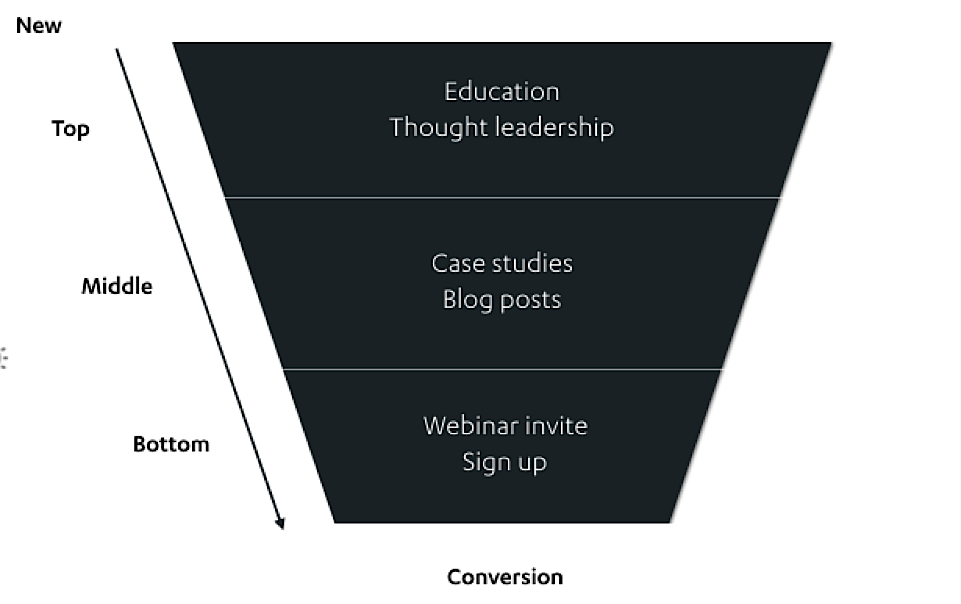
Source: Instapage
At the top of the funnel, you have educational thought-leadership-style content to frame yourself as an authority from your audience’s point of view. Then you’ll send them case studies and more blog posts to help them through the “consideration” phase, or the middle of the funnel. Finally, at the bottom of the funnel when they’re ready to make a purchase decision, you’ll send them a webinar invite or a strategy call sign-up link.
Here’s how Instapage wrote the first email of their funnel:
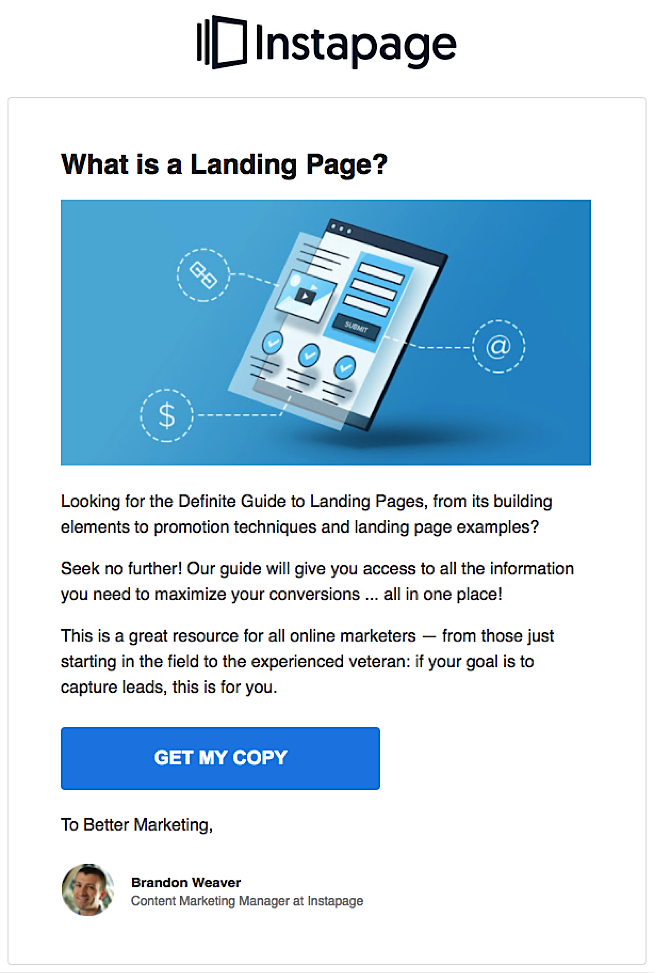
If a reader clicks the link in this email to get their copy, they’ll be sent a “Middle of the Funnel” email with a link to a case study or other type of content relevant to this stage. Then, if they click the link in that email, they’re sent a webinar sign-up email.
It’s a simple approach that qualifies leads as they move along their journey.
Learn More: 6 Cold Email Case Studies with Great Reply Rates
Nurturing Leads Across Channels
“A typical buyer moves quickly from email, to social media, to your website and then back to social media, in the blink of an eye. Marketers need to prepare their lead nurturing strategy for multi-channel engagement. Buyers need to see an integrated experience across every single channel.” – Marketo
Since buyers are purchasing goods and services through multi-channel activities, companies should be considering ways to “meet them where they are.”
While each customer journey can be vastly distinct for each individual prospect, The Marketing Lead Management Report concluded that on average, prospects get 10 marketing “touches” from the period of time they enter the sales funnel until the customer has purchased the service.
However, a another company called Demand Gen discovered in their 2015 landmark study Lead Nurturing Benchmark Study that 49% of marketers usually have less than five touches in their lead nurturing campaigns.
The most successful and sought after nurturing campaigns share content that drives prospects through the customer journey by acknowledging and addressing questions and concerns.
You could focus on building your brand through Facebook pages or constantly putting out content through Twitter. But there’s one strategy that ties in much more easily with email marketing…
Email retargeting.
You can embed retargeting pixels in your emails so that subscribers who open certain emails see specific display ads across the web.
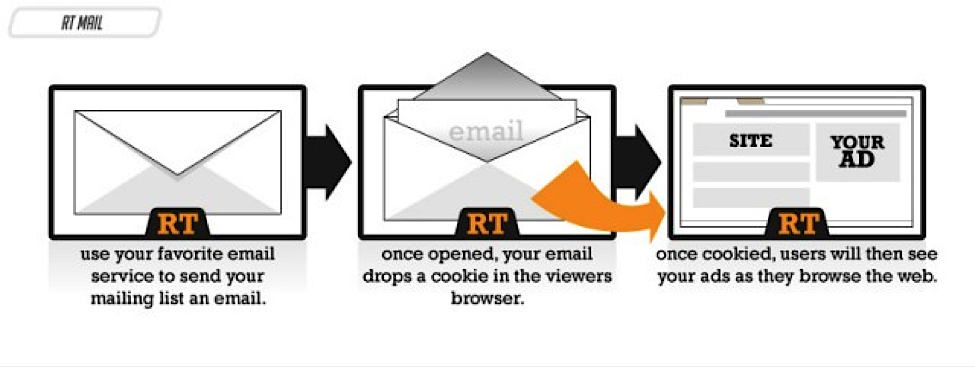
Source: ConversionXL
This way, you can make sure that you’re spending your ad budget effectively and only target subscribers who are most likely to advance to the next step of the customer journey.
Writing Your Emails
One of the most important elements of writing effective lead nurturing emails is personalization. That doesn’t just mean segmenting your subscriber base or writing email copy specific to what your audience wants.
It’s also about adding your own personality into each email and making it feel like you’re actually sitting down and talking to your readers face to face.
Here’s an example of how Wesley Parker, founder of Clicteq, writes emails that feel personal:
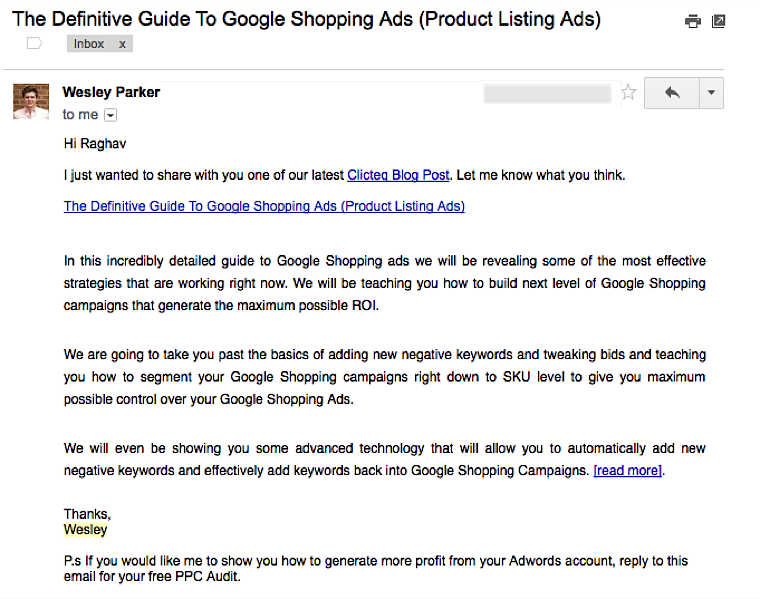
Notice how he:
- Uses the recipient’s name in the greeting. This will immediately separate your email from 99% of the others in your recipient’s inbox.
- Uses the word “you” a lot throughout the email. If you do this, it’ll give your recipients the feeling that you are talking directly to them.
- Encourages his readers to respond. Notice that in the P.S. line, he invites people to reply to the email for a free PPC audit. This does a couple of things. First, if recipients respond to your emails, it’s more likely that future emails will end up in their “Primary” inbox. Secondly, if you respond to their emails one on one, they’ll realize that there’s a real person behind the computer screen.
Learn More: Cold Email Templates that Get Responses
Welcome Emails
Welcome emails are your chance to make a good first impression on your subscribers.
A first rate welcome email makes new customers feel even more excited about their purchase choice and joining your community.
According to a study by Return Path, welcome emails have a read rate of 34%, while other emails have a read rate of 24%. This is because enthusiasm is highest when your subscribers first sign up to your list.
Here are a few things you can do to craft a high-quality welcome email:
Send Emails From An Actual Person’s Address
Prospects are more likely to open email from someone’s personal email address than some kind of software automation. The human touch is imperative in every email campaign.
Andy Sernovitz “Damn, I Wish I’d Thought of That” newsletter comes directly from him.
Add in your personality
Talking to your prospects like you would a friend will strip the corporate angle some prospects might feel initially on your email.
Getting a customer to trust you is the goal and the only way to get there is through relaxed communication. Here’s an email template from WriterAccess – they welcome writers in a quick, personal way:
Hi [name],
Thank you for submitting your profile. It looks great and we’re glad to welcome a fellow Bostonian to our platform!
I approved you for Industry Elite status in Marketing, Travel, Business, Technology, and Relationships so you can receive priority orders from clients in those fields.
Thanks again, welcome aboard, and Happy Writing!
Genevieve
Editorial Assistant
WriterAccess
In this next example, the company sells a split testing service for landing pages. We’ll call it “Quicktest” so it’s easier to read:
Subject Line: Thanks for joining Quicktest! Important info inside
Hi [name],
Thank you for registering for QuickTest. You’ll find that it’s a great way to increase your conversions and boost your profits without any significant legwork.
Here are a few resources from our getting started section that might help you out.
– Step-by-Step Guide to Your First QuickTest Campaign
– FAQS: What is statistically significant? Can I run multiple tests at the same time?
– 101 Conversion-Boosting Tactics To Try Right Now
Again I want to welcome you to our community. I can’t wait to hear about your experience with QuickTest.
Jason
P.S. I’m your customer support hero in charge of keeping you happy. If you have ANY questions… problems… or concerns… please feel free to reach out to ask me before getting frustrated (Skype: JasonTheHero, Email: [email protected])
Give Your Subscribers a Gift
Because your subscribers are interested in your content the most when they first sign up to your list, it’s a great time to offer them a discount. Sending them a small “tripwire” offer right away could help boost your revenue and also keep some of your subscribers more committed to reading future emails and potentially buying other products or services.
Look at how RedBubble sends out their welcome email with a discount code:
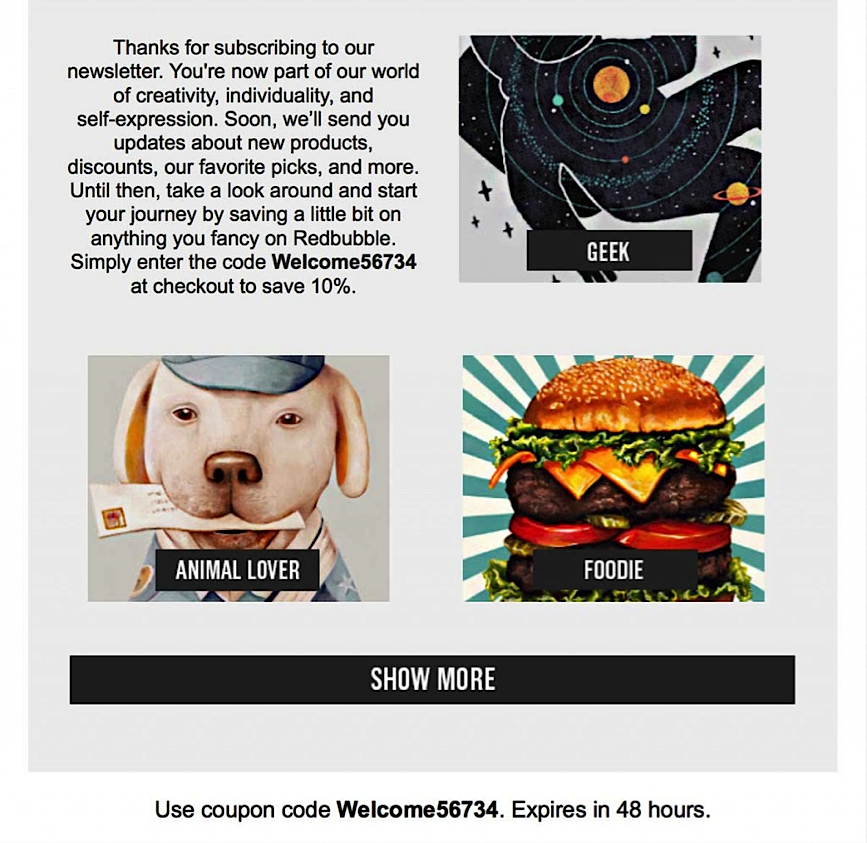
Source: Campaign Monitor
Also notice how RedBubble opens the email with the line with: “You’re now part of our world of creativity, individuality, and self expression.”
Whenever people sign up for anything, they want to feel that they’ve made the right decision. This means that when people sign up for your list, you should reassure them that they’ll be getting a lot of value from it.
Ask subscribers to drag your email to their “Primary” inbox.
Typically, if your subscribers are signed up with their personal Gmail account, your emails will go into either their “Promotions” or “Updates” folder. In your welcome email, ask your subscribers to drag your email to the “Primary” tab of their Gmail inbox or add your email to their address book. This way, you can ensure that your emails will be delivered to your readers. You’ll also see higher open rates.
Here’s an example of how Farnam Street Blog asks for this at the bottom of their welcome email:

Source: Campaign Monitor
Ask subscribers what they want.
One of the easiest ways to start building a relationship with your subscribers from the very beginning is to ask them what their biggest pains are in your area of expertise.
For example, if you run a SaaS company that makes sales teams more efficient, you could ask them to reply to your welcome email with their single biggest challenge around scaling their sales team, hitting quotas, etc.
Responding to an email is a small “investment” that you can encourage subscribers to make. This way, they’ll be more invested in reading future emails because they already feel like they have a connection with you. You can help reinforce this even more by responding to their emails.
Here’s how Wesley Parker from ClickEQ.com encourages responses to his emails:
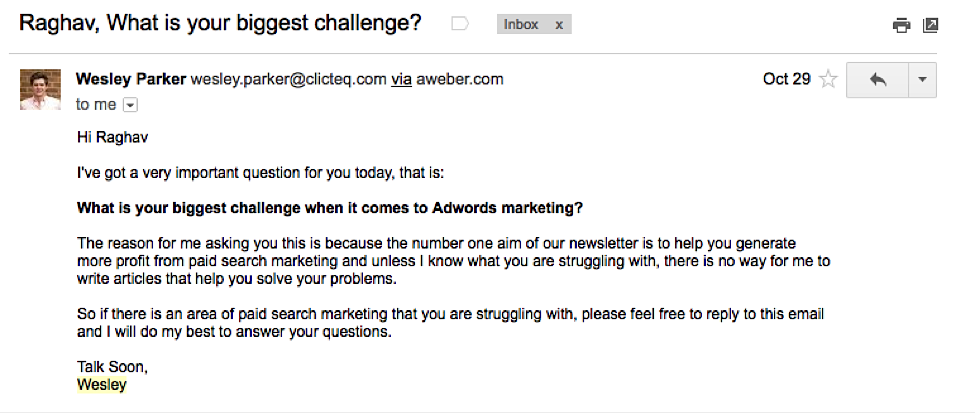
He runs a PPC website, so it made sense to ask his recipients about their biggest challenge when it comes to Adwords marketing. Notice how he also wrote the reason for asking the question — he wants to makes sure that he writes the best content possible for his readers.
If you respond to an email that you get from your readers, you’ll pleasantly surprise them and instantly stand out from all the other marketers in their inbox.
Onboarding Emails
Onboarding emails help you convert more free trial users to paying customers. If done right, onboarding emails help reduce churn, and turn first-time buyers into loyal customers who will purchase from you again and again.
There’s a lot of tactical advice out there when it comes to writing onboarding emails, but there’s one key mistake that many companies make without realizing it.
Instead of educating and nurturing free trial users over time, many marketers try to “nag” their subscribers into making a purchase through emails that don’t add much value.
Most onboarding emails involve some element of “you didn’t take action X, so click this link to do it.” As Customer.io says, if you send these types of emails:
- You’re assuming that the recipient already knows about your product
- You’re assuming that your free-trial users are ready to buy
- You’re assuming that your recipients already intend to use your product
The truth is, these assumptions are rarely true.
There might be some people who are ready to buy immediately after signing up for a trial. But in reality, most users sign up for free trials of multiple products to evaluate them, and in the process they might forget about your product or its key features.
The best onboarding sequences explain your product to your users, how you’ll help them solve their problems and why you’re different. Then you can persuade them to buy.
Onboarding email sequences are similar to lead nurturing emails. You want to send the right email at the right time so that they move forward to the next step in your onboarding sequence.
For example, the first email that Nimble sends to its users is the following:
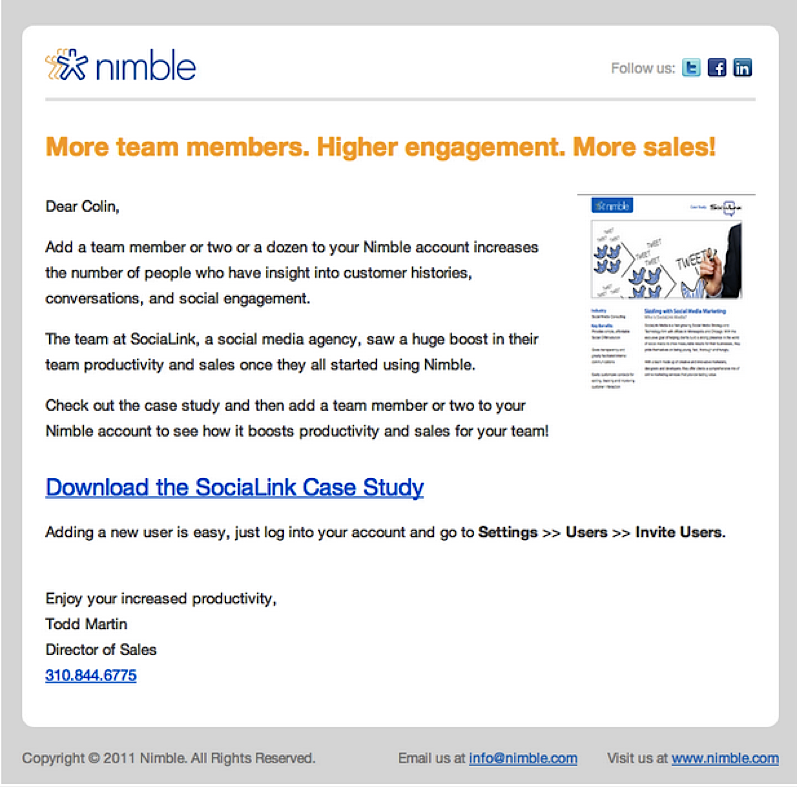
Source: Customer.io
The first step in their onboarding sequence is to encourage users to add team members. But notice how they didn’t just send an impersonal reminder to add team members? They included the following elements in their email:
- A personal greeting so that the reader feels like the writer is talking directly to him
- A personal signature with the name of the director of sales and his phone number
- A reminder to not just add more team members, but telling the reader why he should do it (“SociaLink saw a huge boost in their team productivity and sales once they all started using Nimble”)
- A specific case study that proves why it’s important to add team members to get the most out of Nimble (this helps the recipient realize that adding team members can actually work to his own benefit, and not just Nimble’s)
In addition to reminding your users when they need to take an action, you can also reward certain users when they take an action that moves them forward in your onboarding sequence.
Hackpad sends the following email when users have gotten to know their product a little bit:
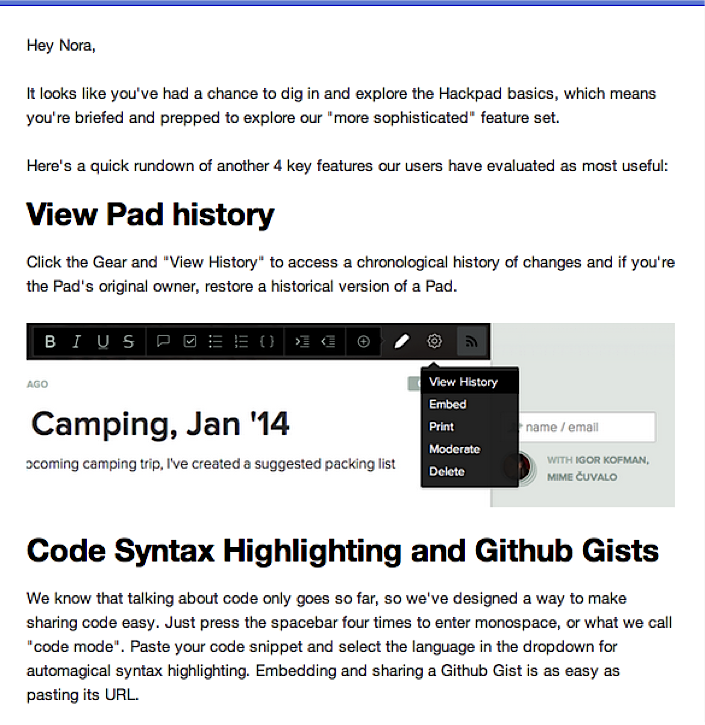
Source: Customer.io
Through their messaging, they make users feel good about using their product. Notice how in the first line they write: “It looks like you’ve had a chance to dig in and explore the Hackpad basics, which means you’re briefed and prepped to explore our ‘more sophisticated’ feature set.”
It feels good to know that you “accomplished” something and get to advance to a another level, even if it just has to do with becoming more familiar with a piece of software.
After the first line, Hackpad also shows users how to use some of their more advanced features by using graphics, so that it’s easy to understand through email. They don’t wait to use tooltips after the user logs in the next time.
Another element of a successful onboarding sequence is to continue educating your users. One mistake that most marketers make is being afraid to send similar pieces of content to subscribers — they believe that subscribers will get tired of seeing similar things again and again in their inbox.
But the truth is, most subscribers don’t actually engage with your content as intently as you’d like. Most of them are just skimming through their emails, so you should always make sure to educate your user base.
Related Content: 7 Ways To Get More People To Open Your Emails [podcast]
Check out how Generator educates subscribers about one of their key features, and why they should care about it:
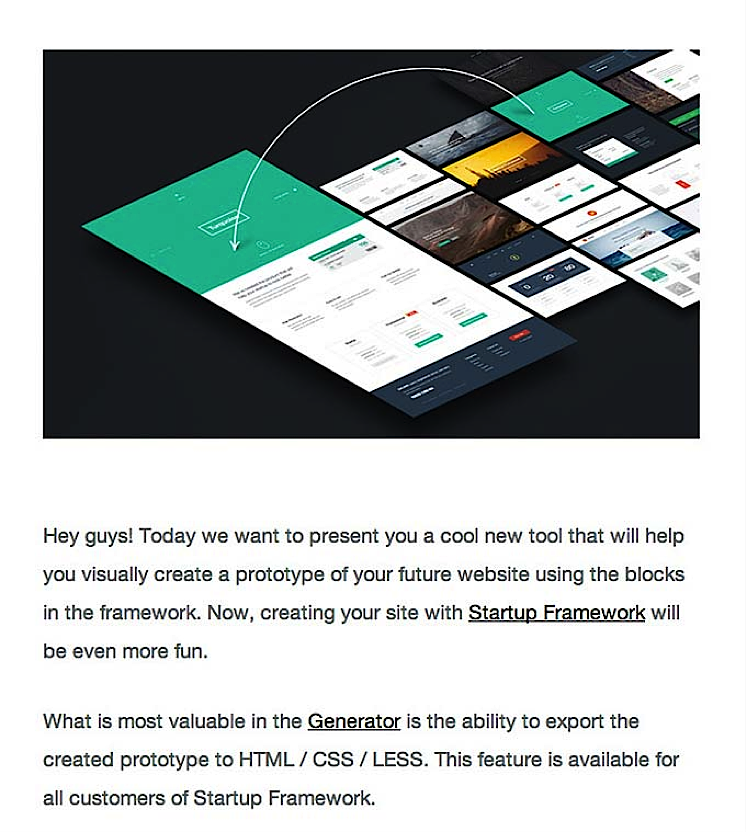
Source: Customer.io
You should never stop educating your subscribers.
Before they buy, education can help them understand what separates your product from everyone else’s. During their free trial or evaluation period, education can help them understand how to use key product features. And after they buy, education can help them feel that their decision to purchase was a good one.
The last element of an effective onboarding email is having a single, clear call to action.
According to an experiment by Sheena Iyengar, a reduction in the number of choices a user is presented with can boost purchases by nearly 30%. The more choices people have, the less likely it is that they’ll choose any of them.
If you give people three or four links to different product features or give them multiple options, then it’s likely that they’ll make none at all. Check out how RunKeeper has a single, clear call to action at the bottom of one of their onboarding emails:
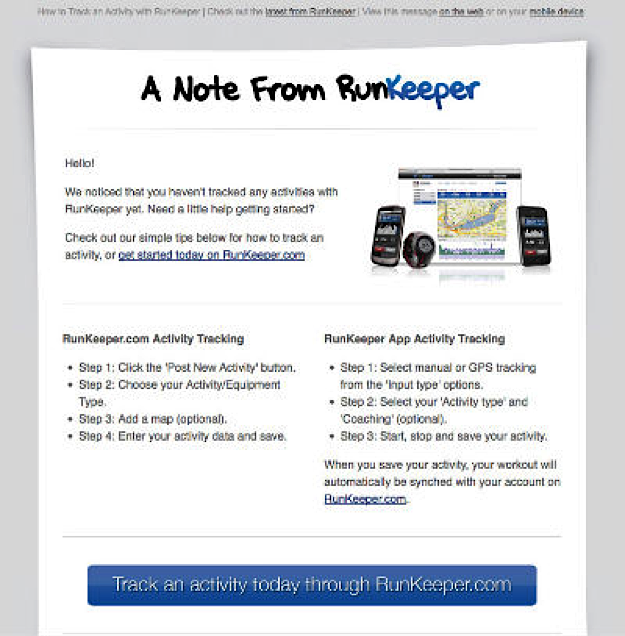
They’ve got several different key product features, but they decided to focus on one in their onboarding email.
If you absolutely must have several call to action elements in your email, check out how Olark did it in their onboarding sequence:
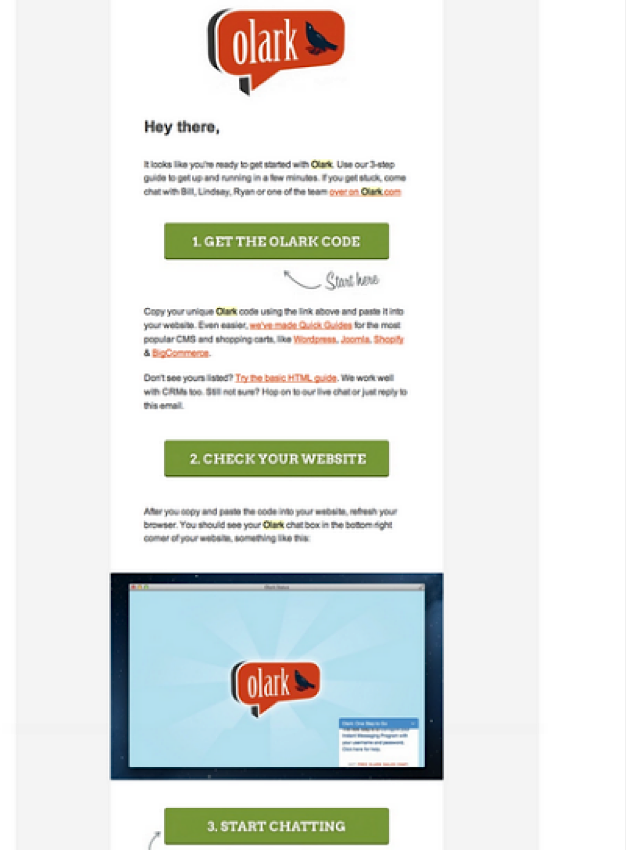
Source: BetaOut
Olark offers a step-by-step guide to help new subscribers use their live chat product. Each call to action is clearly visible and is written in simple language to reduce as much friction as possible in getting new users started with the product.
Related Content: How Neville Medhora Grew AppSumo’s Customer Base to 750k With Email [podcast]
Conclusion
The fundamental key to crafting a high-converting drip campaign is to take your subscribers on a journey.
If you’re trying to nurture leads, you can send your subscribers educational emails, case studies, and sales call sign-up invitations — depending on where they are in the funnel.
Similarly, for an onboarding sequence, you can send users an email to reassure them that they made the right decision in signing up. Then, you can slowly advance them through the process by getting them to take actions that lead them to becoming a paying customer.
If you want to learn more about marketing automation, check out Drip’s free ‘school’ for marketing automation knowledge, with over 20,000 words spread across 5 chapters featuring infographics, podcasts and more.
What other tactics worked for you in crafting high converting drip campaigns? Let us know in the comments!






